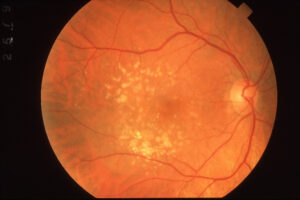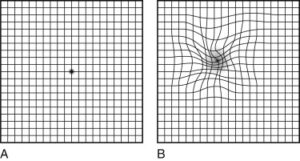Age-Related Macular Degeneration (AMD)
The macula is the central part of the retina responsible for central vision. AMD is a condition which causes loss of central vision. There are two stages of AMD – the “dry” form which is how the disease typically first begins and the more advanced stage called “wet” AMD which is due to abnormal growth of blood vessels causing leakage and hemorrhage.

By Gary R. Cook, MD from Retina Image Bank, 2019
What are risk factors for AMD?
Age greater than 50
Female gender
Smoking (doubles the risk of developing AMD)
Obesity (increases the risk of rapidly progressive AMD)
Vascular diseases (high blood pressure, elevated cholesterol, coronary artery disease, and previous stroke or heart attack)
Family history of AMD
Poor nutrition (Consuming a predominantly plant-based diet especially leafy greens and other vegetables can lower the risk of a poor visual outcome in AMD.)
Lack of activity (Regular exercise can decrease the risk of AMD.)
Caucasian ethnicity (Those with light colored irises have a higher risk of AMD.)
How can I prevent or slow the progression of AMD?
Exercise daily (at least 15 minutes), eat a plant-based diet loaded with leafy greens and other vegetables, do not smoke, and maintain an appropriate weight. Also, wear sunglasses with UV protection and hats when outdoors.
When should I be seen by an eye care professional?
Dilated eye exams are recommended annually to detect AMD and other retinal diseases. Early diagnosis is essential in saving vision.
Symptoms of dry AMD include gradual onset of central blurriness (especially while reading), inability to recognize faces, a need for bright illumination when reading, and loss of color vision.
If you notice rapid onset of central loss of vision in one eye associated with distortion or blind spots, you should be seen within a week of onset as this could indicate the beginning of wet AMD.

Daily monitoring of your vision with an Amsler grid as seen above is a good method of early detection. Image A is a normal grid while Image B demonstrates distortion and blind spots indicative of wet AMD which should prompt an immediate visit to your eye care professional. Many patients with dry AMD will have baseline mild distortion but if there are rapid changes, the possibility of conversion to wet AMD should be considered.
What can be done for AMD?
If you are diagnosed with dry AMD, you will want to be sure you are exercising daily and eating a healthy diet as described above, as well as controlling your weight and maintaining normal blood pressure and cholesterol. You may also wish to consider taking a vitamin called AREDS 2, which may help to slow the progression of the disease.
If you have the more advanced atrophic form of dry AMD, you may benefit from a new treatment involving intraocular injections to slow progression of atrophy which causes gradual loss of vision over time.
Ocular injections of medications have been available since 2005 to treat wet AMD and can preserve and sometimes reverse visual loss. As a retinal specialist, Dr. Keithahn has many years of experience with these medications and is uniquely trained and qualified to administer these injections as well as to determine the proper course of treatment. The goal is to provide enough treatment to stabilize the condition and prevent further visual loss while minimizing the frequency of injections and time spent in the clinic.
• Dry Age-Related Macular Degeneration (AMD) Video
• Medication Injections - Wet Age-Related Macular Degeneration (AMD) Video

